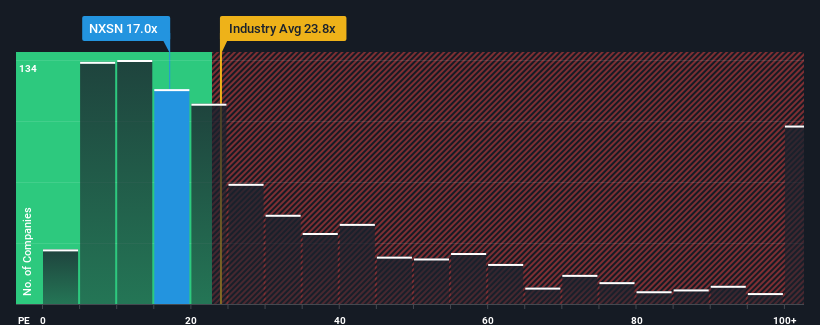- Israel
- /
- Electronic Equipment and Components
- /
- TASE:NXSN
What You Can Learn From NextVision Stabilized Systems, Ltd.'s (TLV:NXSN) P/E
When close to half the companies in Israel have price-to-earnings ratios (or "P/E's") below 11x, you may consider NextVision Stabilized Systems, Ltd. (TLV:NXSN) as a stock to potentially avoid with its 17x P/E ratio. Nonetheless, we'd need to dig a little deeper to determine if there is a rational basis for the elevated P/E.
NextVision Stabilized Systems certainly has been doing a great job lately as it's been growing earnings at a really rapid pace. It seems that many are expecting the strong earnings performance to beat most other companies over the coming period, which has increased investors’ willingness to pay up for the stock. If not, then existing shareholders might be a little nervous about the viability of the share price.
View our latest analysis for NextVision Stabilized Systems

Does Growth Match The High P/E?
The only time you'd be truly comfortable seeing a P/E as high as NextVision Stabilized Systems' is when the company's growth is on track to outshine the market.
Retrospectively, the last year delivered an exceptional 173% gain to the company's bottom line. The strong recent performance means it was also able to grow EPS by 848% in total over the last three years. So we can start by confirming that the company has done a great job of growing earnings over that time.
This is in contrast to the rest of the market, which is expected to grow by 19% over the next year, materially lower than the company's recent medium-term annualised growth rates.
With this information, we can see why NextVision Stabilized Systems is trading at such a high P/E compared to the market. Presumably shareholders aren't keen to offload something they believe will continue to outmanoeuvre the bourse.
The Bottom Line On NextVision Stabilized Systems' P/E
Using the price-to-earnings ratio alone to determine if you should sell your stock isn't sensible, however it can be a practical guide to the company's future prospects.
We've established that NextVision Stabilized Systems maintains its high P/E on the strength of its recent three-year growth being higher than the wider market forecast, as expected. Right now shareholders are comfortable with the P/E as they are quite confident earnings aren't under threat. If recent medium-term earnings trends continue, it's hard to see the share price falling strongly in the near future under these circumstances.
Plus, you should also learn about these 2 warning signs we've spotted with NextVision Stabilized Systems (including 1 which doesn't sit too well with us).
Of course, you might also be able to find a better stock than NextVision Stabilized Systems. So you may wish to see this free collection of other companies that have reasonable P/E ratios and have grown earnings strongly.
Valuation is complex, but we're here to simplify it.
Discover if NextVision Stabilized Systems might be undervalued or overvalued with our detailed analysis, featuring fair value estimates, potential risks, dividends, insider trades, and its financial condition.
Access Free AnalysisHave feedback on this article? Concerned about the content? Get in touch with us directly. Alternatively, email editorial-team (at) simplywallst.com.
This article by Simply Wall St is general in nature. We provide commentary based on historical data and analyst forecasts only using an unbiased methodology and our articles are not intended to be financial advice. It does not constitute a recommendation to buy or sell any stock, and does not take account of your objectives, or your financial situation. We aim to bring you long-term focused analysis driven by fundamental data. Note that our analysis may not factor in the latest price-sensitive company announcements or qualitative material. Simply Wall St has no position in any stocks mentioned.
About TASE:NXSN
NextVision Stabilized Systems
Develops, manufactures, and markets a stabilized day and night photography solution for ground and aerial vehicles in Israel and internationally.
Flawless balance sheet with high growth potential.
Similar Companies
Market Insights
Weekly Picks


Crazy Undervalued 42 Baggers Silver Play (Active & Running Mine)


Fiducian: Compliance Clouds or Value Opportunity?

Willamette Valley Vineyards (WVVI): Not-So-Great Value
Recently Updated Narratives

THE KINGDOM OF BROWN GOODS: WHY MGPI IS BEING CRUSHED BY INVENTORY & PRIMED FOR RESURRECTION


The "Molecular Pencil": Why Beam's Technology is Built to Win


ADNOC Gas future shines with a 21.4% revenue surge
Popular Narratives


MicroVision will explode future revenue by 380.37% with a vision towards success


NVDA: Expanding AI Demand Will Drive Major Data Center Investments Through 2026




